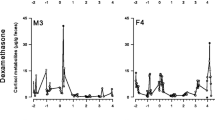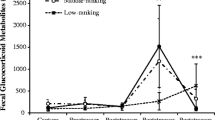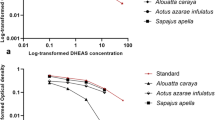Abstract
The measurement of hormones in fecal samples allows for the noninvasive assessment of the endocrine status of free-ranging primates. However, procedures and techniques for hormone analysis in feces must be validated, both analytically and physiologically. Few studies have addressed the endocrinology of black howler monkeys (Alouatta pigra). Due to its conservation status, direct handling of individuals from this species and invasive sample collection are highly regulated, and therefore traditional methods for the validation of hormone assays, such as pharmacological challenges, are not allowed. As a consequence, sometimes studies of the fecal hormones of free-ranging black howler monkeys do not report physiological validations and therefore the biological reliability of such measurements cannot be assessed. In order to stimulate future research with this species, the present study aimed at providing methodological bases for fecal endocrine monitoring. Specifically, we compared the validity of two immunoassays (radioimmunoassays, RIA; solid-phase chemiluminescent enzyme immunoassay, SPCEI) performed with commercial kits to measure cortisol, testosterone, estradiol, and progesterone; and demonstrate how the physiological functions of these steroid hormones can be determined through non-pharmacological validations. We found no differences between the analytical validity of RIA and SPCEI assays to measure cortisol and testosterone, whereas for estradiol and progesterone RIA showed better results. Concerning the physiological validation of our assays, we demonstrated that: (1) comparisons between pre- and post-stress situations may be used to assess cortisol response, (2) comparisons between females and males may be used to assess variation in testosterone levels, and (3) comparisons between pregnant and non-pregnant females may be used to determine variation in estradiol and progesterone activity. The analytical and physiological validations that we performed demonstrate that there are currently commercial kits that allow for correct endocrine monitoring of this species, and that there are non-pharmacological alternatives to assess the biological validity of hormone measurements.

Similar content being viewed by others
References
Bahr NI, Palme R, Möhle U, Hodges JK, Heistermann M (2000) Comparative aspects of the metabolism and excretion of cortisol in three individual non-human primates. Gen Comp Endocrinol 117:427–438
Behie AM, Pavelka MS, Chapman CA (2010) Sources of variation in fecal cortisol levels in howler monkeys in Belize. Am J Primatol 72:600–606
Canales-Espinosa D, Dias PAD, Rangel-Negrín A, Aguilar-Cucurachi S, García-Orduña F, Hermida-Lagunes J (2011) Translocación de primates mexicanos. In: Dias PAD, Rangel-Negrín A, Canales-Espinosa D (eds) La conservación de los primates en México. Consejo Veracruzano de Ciencia y Tecnología, Xalapa, pp 1–107
Clarke M, Zucker EL, Randall TF, Harrison RM (2007) Behavior and endocrine concentrations do not distinguish sex in monomorphic juvenile howlers (Alouatta palliata). Am J Primatol 69:477–484
Coe CL, Savage A, Bromley LJ (1992) Phylogenetic influences on hormone levels across the primate order. Am J Primatol 28:81–100
Cristóbal-Azkarate J, Chavira R, Boeck L, Rodríguez-Luna E, Veá JJ (2006) Testosterone levels of free-ranging resident mantled howler monkey males in relation to the number and density of solitary males: a test of the challenge hypothesis. Horm Behav 49:261–267
Diario Oficial de la Federación (2013) Ley general de vida silvestre. México D.F.: Cámara de Diputados del H. Congreso de la Unión
Dias PAD, Rangel-Negrín A, Canales-Espinosa D (2011) Effects of lactation on the time-budgets and foraging patterns of female black howlers (Alouatta pigra). Am J Phys Anthropol 145:137–146
Dixson AF (2013) Primate sexuality: comparative studies of the prosimians, monkeys, apes, and humans, 2nd edn. Oxford University Press, New York
Goymann W (2012) On the use of non-invasive hormone research in uncontrolled, natural environments: the problem with sex, diet, metabolic rate and the individual. Methods Ecol Evol 3:757–765
Heistermann M, Palme R, Ganswindt A (2006) Comparison of different enzyme immunoassays for assessment of adrenocortical activity in primates based on fecal samples. Am J Primatol 68:257–273
Hodgen GD, Itskovitz J (1988) Recognition and maintenance of pregnancy. In: Knobil E, Neill JD (eds) The physiology of reproduction. Raven, New York, pp 1995–2021
Hodges K, Brown J, Heistermann M (2010) Endocrine monitoring of reproduction and stress. In: Kleiman DG, Thompson KV, Kirk Baer C (eds) Wild mammals in captivity: principles and techniques for zoo management. The University of Chicago Press, Chicago, pp. 447–468
Horwich RH, Johnson ED (1986) Geographical distribution of the black howler (Alouatta pigra) in Central America. Primates 27:53–62
Khan MZ, Altmann J, Isani SS, Yu J (2002) A matter of time: evaluating the storage of fecal samples for steroid analysis. Gen Comp Endocrinol 128:57–64
Martínez-Mota R, Valdespino C, Sánchez-Ramos MA, Serio-Silva JC (2007) Effects of forest fragmentation on the physiological stress response of black howler monkeys. Anim Conser 10:374–379
Martínez-Mota R, Valdespino C, Rivera Revolledo JA, Palme R (2008) Determination of fecal glucocorticoid metabolites to evaluate stress response in Alouatta pigra. Int J Primatol 29:1365–1373
Nguyen N (2013) Primate behavioral endocrinology. In: Sterling EJ, Bynum N, Blair MR (eds) Primate ecology and conservation. Oxford University Press, Oxford, pp 224–237
Norman AW, Litwack G (1997) Hormones, 2nd edn. Academic Press, New York
Palme R (2005) Measuring fecal steroids: guidelines for practical application. Ann NY Acad Sci 1046:75–80
Palme R, Fischer P, Schildorfer H, Ismail MN (1996) Excretion of infused 14C-steroid hormones via faeces and urine in domestic livestock. Anim Reprod Sc 43:43–63
Palme R, Rettenbacher S, Touma C, El- Bahr SM, Möstl E (2005) Stress hormones in mammals and birds: comparative aspects regarding metabolism, excretion, and noninvasive measurement in fecal samples. Ann NY Acad Sci 1040:162–171
Pepe GJ, Albrecht ED (1995) Actions of placental and fetal adrenal steroid hormones in primate pregnancy. Endocr Rev 16:608–648
Rangel-Negrín A, Alfaro JL, Valdez RA, Romano MC, Serio-Silva JC (2009) Stress in Yucatan spider monkeys: effects of environmental conditions on fecal cortisol levels in wild and captive populations. Anim Conserv 12:496–502
Rangel-Negrín A, Dias PAD, Chavira R, Canales-Espinosa D (2011) Social modulation of testosterone in male black howlers (Alouatta pigra). Horm Behav 59:159–166
Ryan KJ, Hopper BR (1974) Placental biosynthesis and metabolism of steroid hormones in primates. Contrib Primatol 3:258–283
Sapolsky RM, Romero LM, Munck AU (2000) How do glucocorticoids influence stress responses? Endocr Rev 21:55–89
Siemens (2014) Healthcare Siemens. http://usa.healthcare.siemens.com/. Accessed 24 Jan 2014
Stratakis CA, Chrousos GP (1995) Neuroendocrinology and pathophysiology of the stress system. Ann NY Acad Sci 771:1–18
Swerdloff RS, Wang C, Sinha-Hikim AP (2009) Hypothalamic-pituitary-gonadal axis in men. In: Pfaff DW, Arnold AP, Etgen AM, Fahrbach SE, Rubin RT (eds) Hormones, brain, and behavior, 2nd edn. Academic Press, San Diego, Part V, pp 2357–2393
Touma C, Palme R (2005) Measuring fecal glucocorticoid metabolites in mammals and birds: the importance of a biological validation. Ann NY Acad Sci 1046:54–74
Van Belle S, Estrada A, Ziegler TE, Strier KB (2009a) Social and hormonal mechanisms underlying male reproductive strategies in black howler monkeys (Alouatta pigra). Horm Behav 56:355–363
Van Belle S, Estrada A, Ziegler TE, Strier KB (2009b) Sexual behavior across ovarian cycles in wild black howler monkeys (Alouatta pigra): male mate guarding and female mate choice. Am J Primatol 71:153–164
Wasser SK, Hunt KE, Brown JL et al (2000) A generalized fecal glucocorticoid assay for use in a diverse array of nondomestic mammalian and avian species. Gen Comp Endocrinol 120:260–275
Acknowledgments
We are grateful to all field assistants for their dedicated work, in particular to A. Coyohua; to the personnel of the Instituto de Neuroetología that collaborated in the capture of animals; and to S. Cruz–Sanchez, A. Trigos, and L. Boeck for support during laboratory work. J. Beehner and C. M. Schaffner, an Associate Editor of the journal and a reviewer provided very useful comments on previous versions of the manuscript. This study was supported by CFE (RGCPTTP-UV-001/04), Universidad Veracruzana, Conacyt (grant number: 235839, i010/458/2013 & C‐703/2013), and Idea Wild. Our research complied with the Mexican law and with the Guidelines for the Treatment of Animals in Behavioral Research and Teaching from the Animal Behavior Society.
Author information
Authors and Affiliations
Corresponding author
About this article
Cite this article
Rangel-Negrín, A., Flores-Escobar, E., Chavira, R. et al. Physiological and analytical validations of fecal steroid hormone measures in black howler monkeys. Primates 55, 459–465 (2014). https://doi.org/10.1007/s10329-014-0432-4
Received:
Accepted:
Published:
Issue Date:
DOI: https://doi.org/10.1007/s10329-014-0432-4




